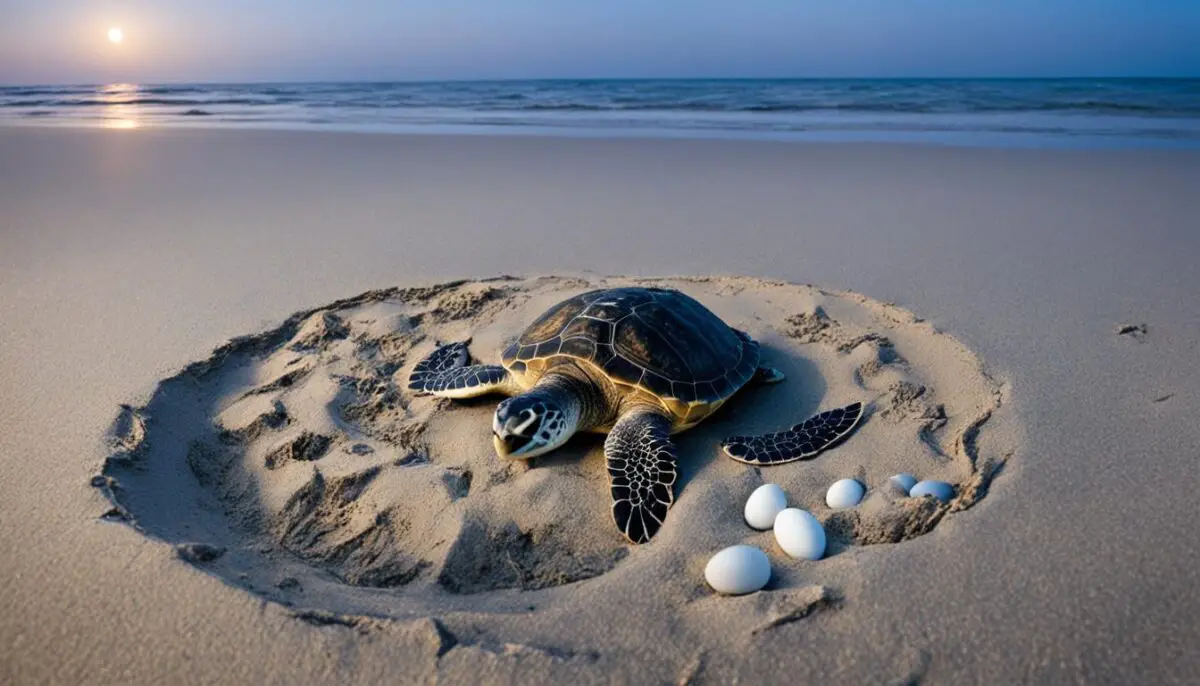Sea turtles are fascinating creatures that captivate the imagination with their remarkable nesting habits. Understanding the nesting process and the locations where sea turtles lay their eggs is essential for conservation efforts and ensuring the survival of these magnificent species.
Sea turtles play a vital role in the ecosystem, and their reproduction is a crucial part of their life cycle. By investigating the secrets of their nesting habits, we gain valuable insights into their behaviors and the challenges they face.
Key Takeaways:
- Sea turtles lay their eggs on beaches worldwide to ensure the continuation of their populations.
- Popular sea turtle nesting sites include Turtle Island National Park, Ras Al Jinz, Nosy Iranja, Mnemba Island, Coco and Félicité.
- The nesting process involves digging a body pit, creating an egg chamber, laying eggs, and covering the nest with sand.
- The temperature of the nest determines the sex of the hatchlings, with cooler temperatures producing males and warmer temperatures resulting in females.
- Sea turtle hatchlings face predation and human-induced threats as they make their way to the sea.
Popular Nesting Sites for Sea Turtles
Sea turtles are known to lay their eggs in various locations around the world. These nesting sites provide essential habitats for these magnificent creatures to complete their life cycle. Let’s explore some of the popular nesting sites frequented by sea turtles during their nesting season.
Turtle Island National Park, Borneo

Sea turtle nests are fascinating structures that play a critical role in the survival of these magnificent creatures. The careful and deliberate process followed by female sea turtles ensures the safety and proper incubation of their precious eggs. By understanding the nesting process, we can appreciate the incredible efforts made by sea turtles to ensure the continuation of their species.
Factors Affecting Sea Turtle Hatchlings
Sea turtle hatchlings are highly influenced by various factors that impact their survival and development. Two crucial elements that play a significant role in the lives of these vulnerable creatures are temperature-dependent sex determination and predation.
The Role of Temperature in Hatchling Sex Determination
Sea turtle hatchlings have a fascinating phenomenon known as temperature-dependent sex determination. The temperature inside the nest directly affects the sex ratio of the emerging hatchlings. Cooler temperatures during incubation tend to produce primarily male hatchlings, whereas warmer temperatures result in a higher proportion of female hatchlings. This process is crucial for maintaining a balanced population of sea turtles.
This temperature sensitivity is linked to the hormones that control sexual development in sea turtle embryos. As the temperature fluctuates within the nest, it influences the production and reception of hormones, ultimately determining the gender of the hatchlings.
Natural Predation and Its Impact on Hatchling Survival
Once the sea turtle hatchlings emerge from their nests, they face a myriad of natural predators. Birds, crabs, and other animals eagerly await their chance to prey upon these defenseless creatures. The exposed journey from the nest to the sea presents numerous dangers, and only a small percentage of hatchlings successfully reach the water.
Additionally, human activities have further increased the vulnerability of sea turtle hatchlings. Artificial lighting along the coast can disorient hatchlings, drawing them away from the sea and thus reducing their chances of survival. Coastal development also poses a threat by encroaching upon nesting sites, disrupting natural habitats.
Table: Predators of Sea Turtle Hatchlings
| Predator | Description |
|---|---|
| Birds | Seagulls, frigatebirds, and other avian species feed on hatchlings as they crawl towards the sea. |
| Crabs | Ghost crabs and other crab species actively prey on hatchlings, remaining a significant threat along sandy beaches. |
| Other Animals | Raccoons, foxes, and even some predatory fish are known to target turtle hatchlings during their vulnerable journey. |
It is crucial to address these threats to ensure the survival of sea turtle hatchlings and maintain healthy populations of these magnificent creatures.
Conclusion
Sea turtles face numerous challenges that threaten their survival, including loss of nesting habitats, pollution, climate change, and accidental capture in fishing gear. However, conservation efforts and the establishment of protected nesting sites have been crucial in maintaining and increasing sea turtle populations. It is imperative that we continue to protect and conserve sea turtles, as they play a vital role in marine ecosystems and are a symbol of the importance of preserving the world’s oceans. By understanding their nesting behaviors and supporting conservation initiatives, we can ensure a brighter future for these incredible creatures.
FAQ
Where do sea turtles lay their eggs?
Sea turtles lay their eggs on beaches worldwide. They emerge from the sea and search for a suitable nesting site on the beach.
What are some popular nesting sites for sea turtles?
Some popular nesting sites for sea turtles include Turtle Island National Park in Borneo, Ras Al Jinz in Oman, Nosy Iranja in Madagascar, Mnemba Island in Zanzibar, and Coco and Félicité in Seychelles.
What is the nesting process of sea turtles?
When a female sea turtle is ready to lay her eggs, she digs a hole known as a body pit, then digs an egg chamber. She lays her eggs in the chamber, covers the nest with sand, and camouflages it to protect it from predators. The eggs incubate for about 60 days, and the hatchlings emerge and make their way to the sea.
What factors affect sea turtle hatchlings?
The temperature of the nest plays a crucial role in determining the sex of sea turtle hatchlings. Predation by birds and crabs is also a significant factor affecting hatchlings.
Why are sea turtles important to conserve?
Sea turtles are important to conserve as they play a vital role in marine ecosystems and symbolize the importance of preserving the world’s oceans. Conservation efforts are necessary to protect sea turtles from threats such as loss of nesting habitats, pollution, climate change, and accidental capture in fishing gear.

